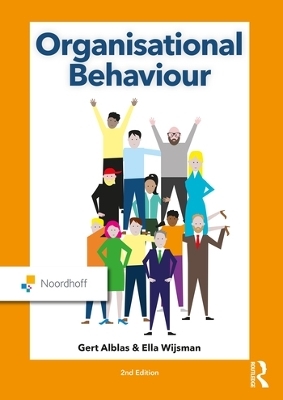
Organisational Behaviour
Wolters-Noordhoff B.V. (Verlag)
978-90-01-89895-3 (ISBN)
For many years, Organisational Behaviour has been the number one introduction into organisational psychology. Alblas and Wijsman offer an inspirational description of the behaviour of people in organisation and offer explanations for these behaviours.
Moreover, the authors indicate how this knowledge can be put to use in managing an organisation. This makes Organisational Behaviour a suitable work for a vast range of courses in higher economic, technical, and social education alike.
The inclusion of newspaper and online articles in this addition clearly illustrates its applicability in practice.
Its clear use of language, comprehensive summaries, case histories with evaluation assignments, and practice tests on the accompanying website make this book a very suitable tool for self-study.
Gert Alblas is an social and organisational psychologist and used to be a university lecturer at the University of Groningen and the open University of the Netherlands. He currently works as a writer. He has written several books on psychology, management, and organisation for Noordhoff Uitgevers. Ella Wijsman is a psychologist specialising in organisational psychology and management theory and taught at various (vocational) universities. In addition, she also designed and coordinated management trainings and provided training and coaching in both the profit and non-profit sectors. She is the author of Psychology & Sociology, a standard reference work in this branch of study in the Netherlands.
Introduction
1 Individual and organisation
1.1 Behaviour and motivation
1.2 Abilities and competences
1.3 Personality
1.4 Attitudes
1.5 The relationship between individual and organisation
1.6 Commitment
1.7 Job satisfaction
1.8 Equitability
1.9 Changing relationships
2 Integration and motivation
2.1 Recruitment and selection
2.2 Integration
2.3 Methods of integration
2.4 Motivation
2.5 Effects of motivation
2.6 Intrinsic and extrinsic motivation: conclusions
2.7 Retaining people in an organisation
3 Groups in organisations
3.1 The group concept
3.2 The organisation as a collection of groups
3.3 Types of groups in organisations
3.4 Functions of groups
3.5 The group as a social environment
3.6 Phases in group development
3.7 Structural characteristics of groups
3.8 Relationships between groups
3.9 Improving relationships between groups
4 Collaboration and decision-making in groups
4.1 Effective collaboration in groups
4.2 Process losses in executive groups
4.3 Optimising group performance
4.4 Effective decision-making in groups
4.5 Advantages and disadvantages of a group approach
4.6 Criteria for effective decision-making
in a group context
4.7 Process losses in decision-making
4.8 Improving decision-making in groups
4.9 Leadership in decision-making
4.10 Collaboration and consultation in self-managing and virtual teams
5 Communication in organisations
5.1 Communication
5.2 The communication process
5.3 Aspects of communication
5.4 Communication in organisations
5.5 Impediments to communication
5.6 Problems in formal communication
5.7 Improving communication
6 Power and leadership
6.1 Power and influence
6.2 Sources of power
6.3 Use of power
6.4 Effects of use of power
6.5 Use of power for political purposes
6.6 Abuse of power
6.7 Leadership in organisations
6.8 Leadership and effectiveness
6.9 Improving leadership
6.10 Influence of leadership
7 Organisational structure
7.1 Creating structure
7.2 Distribution of labour
7.3 Functional division
7.4 Coordination of activities
7.5 Grouping activities
7.6 Responsibilities and relationships
7.7 Additional forms of authority and mutual relationships
7.8 Designing communication channels
7.9 Organic and mechanistic structures
7.10 Developments in structural design
7.11 Design questions
8 Organisational culture
8.1 The concept of culture
8.2 Organisational culture
8.3 Types of organisational culture
8.4 Organisational culture and effectiveness
8.5 Establishing the culture of organisations
8.6 The development of organisational culture
8.7 Transmitting organisational culture
8.8 Organisational culture and nationality
8.9 Cultural bias
8.10 Changing the organisational culture
9 Decision-making in
organisations
9.1 Characteristics of problems
9.2 Areas of decision-making in organisations
9.3 Problems in decision-making
9.4 Impediments to decision-making
9.5 Decision-making models
9.6 Strategic decision-making
9.7 Model for strategy formulation
9.8 Organizing strategic decision-making
10 Stress and conflict
10.1 Psychological load
10.2 Work-related causes of stress and burn-out
10.3 Person-related causes of stress and burn-out
10.4 Preventing or combating stress and burn-out
10.5 Physical load
10.6 Reducing the physical load
10.7 Conflicts at work
10.8 Conflict management
10.9 Conditions that influence conflict management
10.10 Escalation of conflicts
10.11 Organisational intervention in conflict resolution
11 Organisational change
11.1 Necessity for change
11.2 Causes of change
11.3 Deciding to change
11.4 Planned organisational change
11.5 Types of change
11.6 Two approaches to planned change
11.7 Impediments to the change process
11.8 The role of management in change processes
11.9 Creating a structure for handling change
11.10 Reducing resistance and increasing support
Bibliography
About the authors
Index
Illustration acknowledgement
| Erscheinungsdatum | 28.05.2021 |
|---|---|
| Reihe/Serie | Routledge-Noordhoff International Editions |
| Zusatzinfo | 88 Line drawings, color; 92 Halftones, color; 180 Illustrations, color |
| Verlagsort | Groningen |
| Sprache | englisch |
| Maße | 170 x 240 mm |
| Gewicht | 850 g |
| Themenwelt | Geisteswissenschaften ► Psychologie ► Arbeits- und Organisationspsychologie |
| Wirtschaft ► Betriebswirtschaft / Management ► Planung / Organisation | |
| ISBN-10 | 90-01-89895-5 / 9001898955 |
| ISBN-13 | 978-90-01-89895-3 / 9789001898953 |
| Zustand | Neuware |
| Haben Sie eine Frage zum Produkt? |
aus dem Bereich


